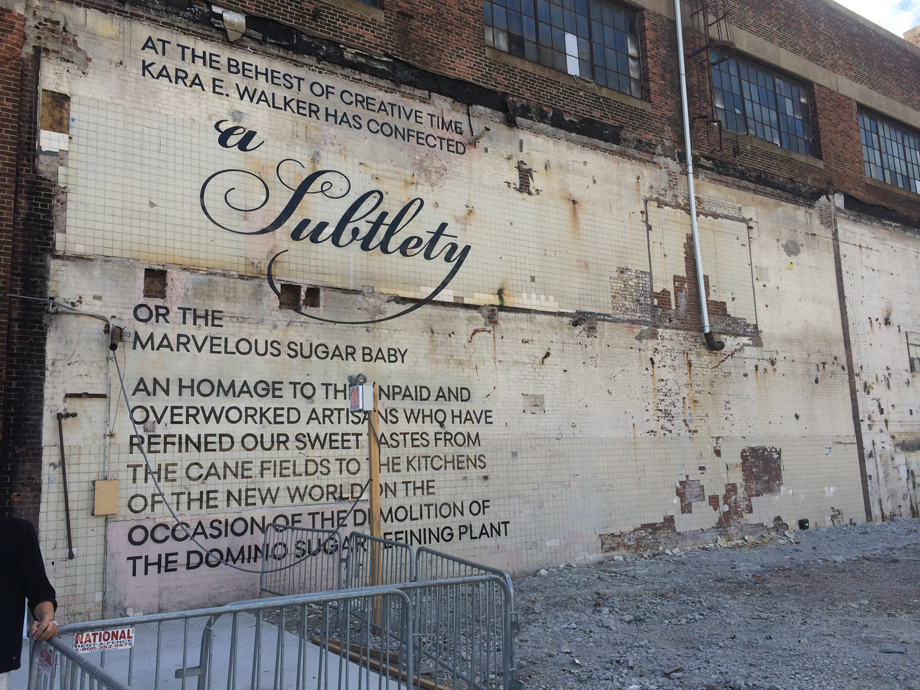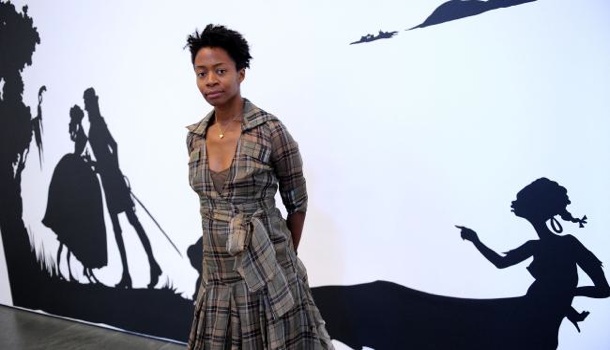
“…Just seconds ago, they had been aiming their lenses at the sculpture of a 40-foot tall, nude black female sphinx. Many posed under its ass; some laughed and pointed at its vulva. … [I] turned to face them and began yelling.”
Art provides an open space for one to explore their innermost observations of the world. Within context, a reflection of life as experienced by those that came before us and those who study and search for the depths of previous life journeys express their responses and/or interpretations within their art.
Such is the case with the controversial Kara Walker exhibit, which displayed in New York City at the Domino Sugar Factory in Brooklyn. The exhibit, titled ‘A Subtlety,’ included a 5-foot tall, 75-foot long, Mammy-type sphinx with a ponderous bosom, full lips and a flat nose – and coated with 40 tons of pure white sugar — as part of its display. The exhibit also showcased sculpted children as they worked and carried sugar in the fields. Its purpose, as stated by its creator, is to reflect slavery and pay homage to the artisans who worked relentlessly in the sugar cane fields.
 The quote that heads this piece is the reaction from Nicholas Powers, author of The Ground Below Zero, while visiting the exhibit. His outrage, as described further in his editorial, discusses the poorly enlightened and misunderstanding of the statement ‘A Subtlety’ presents. He is upset at the White population’s disrespect — taking pictures posing next to the sphinx’s breasts while laughing, mocking the struggle and history of Black people. Not understanding the significance in its sugary makeup and the messaging that hits home for many individuals whose ancestors’ history lives through this presentation.
The quote that heads this piece is the reaction from Nicholas Powers, author of The Ground Below Zero, while visiting the exhibit. His outrage, as described further in his editorial, discusses the poorly enlightened and misunderstanding of the statement ‘A Subtlety’ presents. He is upset at the White population’s disrespect — taking pictures posing next to the sphinx’s breasts while laughing, mocking the struggle and history of Black people. Not understanding the significance in its sugary makeup and the messaging that hits home for many individuals whose ancestors’ history lives through this presentation.
“In the time of slavery, sugar was considered a blood commodity,” Walker, whose contemporary art explores race, gender, sexuality violence and identity, told CBS News. Her work identifies the Black struggle and doesn’t shy away from vivid creations of violence while bringing the depths of the African experience to the forefront.
‘A Subtlety’, which had its final showing July 6th, drew large crowds and sparked interesting dialogue. Many posted pictures on social media posing in front of the sphinx or pointing at its breasts and/or vulva. Beyonce and Jay-Z had baby Blue on hand while gazing at the sphinx. June Ambrose took her children to see it as well, captioning one of her Instagram photos, “I have some explaining to do” as her young daughter stood with her mouth ajar and eyes bulging.
Often heard reactions regarding something of this magnitude are: Powerful. Deep. Wow. Speechless.
And true, oftentimes they are these descriptions. What’s rarely expressed in the same space as fellow art viewers is a public reaction of anger—an outburst of enraged emotions.
Art, no matter its beauty or harsh revelation nor how powerful it can be, can also invite tension and criticism.
After attending an earlier Kara Walker exhibit, Powers questioned the artist’s responsibility, stating: “I wondered… if exposing the details of Black victimization was truly freeing if it simply triggered the pain of people of color, and in the precarious atmosphere of the nearly all-white art world at that.”
Powers raised the same question after witnessing ‘A Subtlety’.
I now ask you, what are your thoughts when it comes to artist responsibility and showcasing the depths of historical struggle within African-American culture?
Digest that and let’s discuss.


